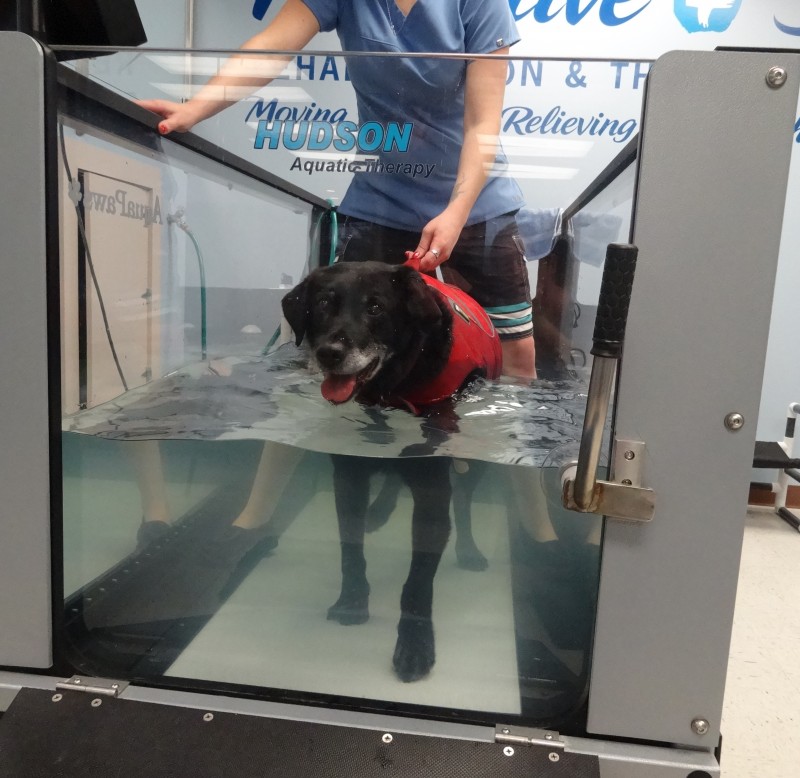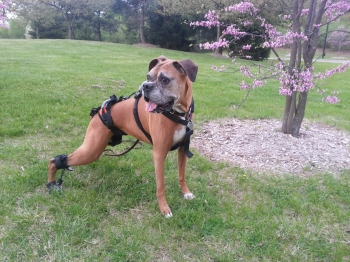Degenerative Myelopathy: The “Lou Gehrig’s” Disease of Dogs
By Lisa Blanchard BA, LVT, CMT, CCRP, CCFT
WHAT IS DEGENERATIVE MYELOPATHY (A.K.A. DM)?

Luke is shown here, exercising in the underwater treadmill. While Luke has been not been officially diagnosed with DM, his symptoms are very indicative of the disease.
Basic definition breakdown: 1) Degenerate – to lose functional activity. 2) Myelopathy – disturbance or disease of the spinal cord.
Degenerative myelopathy in dogs most parallels the disease in ALS or Lou Gehrig’s disease in humans. Like ALS, DM is not a painful disease. It affects mature dogs usually between the ages of 8-14 years. It is a slow progressive, non-inflammatory deterioration of the white matter of the spinal cord (1). The white matter is significant as it helps transmit information from the brain to the dog’s limbs (2). As the white matter degenerates the dog loses coordination making it difficult to walk.
The disease will usually start in one hind limb eventually progressing to the other hind limb. The dog will look ataxic (wobbly), start to scuff its feet, and ultimately knuckle over walking on the tops of its paws. The disease accelerates until the dog is unable to walk and is paraplegic in the rear limbs. This progression can take anywhere from 6 months to 3 years depending on the severity of the signs (1)(2). As the disease continues into advanced stages the dog will lose urinary and fecal continence, and eventually the disease will affect the front limbs as well. During the final stage of the disease the dog usually succumbs to respiratory failure. Due to quality of life concerns most dogs are humanely euthanized before they get to this stage.
GENETIC TESTING
The dog breeds most affected by this disease are the Hovawart, Pembroke Welsh Corgi, German Shepherd, Boxer, Golden Retriever, Chesapeake Bay Retriever, Rhodesian Ridgeback, and Bernese Mountain Dog. Mixed breed are affected as well. Genetic research is ongoing in many other breeds. A genetic test is available for all dogs through the Orthopedic Foundation for Animals. It is a simple cheek swab of saliva that will tell if your dog tests clear (2 normal copies of the DM gene), is a carrier (one normal copy and one mutated copy of the gene), or is at risk of developing DM (has 2 mutated copies of the gene) (3).
DIAGNOSING THE DISEASE
Recognizing and diagnosing degenerative myelopathy (DM) in dogs can be difficult as other conditions can present similarly to the disease. Diagnosing DM is often a process of “ruling out” other pathological conditions such as arthritis, herniated disks, spinal tumors, stroke, infection, lumbosacral disease, etc. Diagnostic tests such as blood work, x-rays, CSF taps, myelography and MRI can help rule out any of the aforementioned pathologies. Since DM is a progressive disease, if there is a sudden onset of symptoms this diagnosis can be ruled out.

TREATMENT
Currently there is no known treatment for DM. Once the symptoms have started to appear the damage has begun. Treatment is more of a management process. The goal is to maximize the function and the quality of life of the dog during each stage of the disease. However physical exercise appears to be a key component to helping DM dogs live longer. A study published by the Journal of Veterinary Internal Medicine reported dogs diagnosed with DM who had intense rehabilitation therapy lived an average of 255 days compared to dogs who received no therapy (55 days). Creating a custom home exercise program with a rehabilitation veterinarian is crucial for DM dogs (4). Too much exercise for these patients can be detrimental as their muscles easily become fatigued.
Walking in the underwater treadmill can also be beneficial. It gives DM dogs buoyancy to aid them in holding up their body weight hence they can then concentrate on moving their limbs through the water which encourages muscle building. Having to walk on a timed belt as opposed to on ground challenges their propriopception (where are my feet in space). In addition, modalities such as massage, acupuncture, and laser therapy can help to increase blood flow and stimulate the nervous system.
ASSISTIVE DEVICES & LIFESTYLE CHANGES
As the disease continues to progress most dogs will need help in some form of an assistive device. Booties to protect the paws as they knuckle over are imperative to prevent infection, harnesses will assist the dog in rising and with walking.
When the time is right carts are wonderful devices for giving the dog freedom. They should not be saved for end-stage disease management. They can be used as rehabilitation tools to help keep the dog strong as the disease advances. The dog can stand in the cart and use its rear legs with support and when the time comes; its feet can be put back into stirrups.
At home make sure that your floors are covered with latex-backed rugs or yoga mats so your dog does not slide. Check your dog’s feet to ensure that its nails are trimmed and there is no excess hair between the pads. This excess hair is like sliding on ice and causes them to lose their balance. If your dog is losing coordination, block off access to stairs and slippery surfaces. Use ramps or stairs to get your dog in and out of the car or on the bed.
DM is a debilitating and devastating disease for which there is no cure. However it can be managed. We are there to support you and your pet during the process of the disease to help maximize your dog’s function and quality of life.
ADDITIONAL INFORMATION:
For more information on carts, see last month’s blog entitled Burning Rubber: Pet Carts in Rehabilitation.
